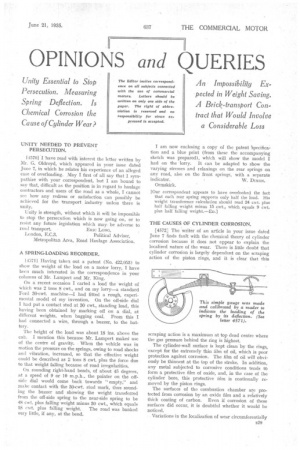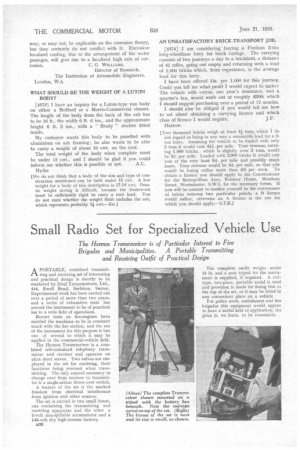OPINIONS and QUERIES
Page 43

Page 44

If you've noticed an error in this article please click here to report it so we can fix it.
UNITY NEEDED TO PREVENT PERSECUTION,
14570] I have read with interest the letter written by Mr. G. Oldroyd, which appeared in your issue dated June 7, in which he relates his experience of an alleged case of overloading. May I first of all say that I sympathize with your correspondent, but I am bound to say that, difficult as the position is in regard to haulage contractors and users of the road as a whole, I cannot see how any redress or satisfaction can possibly be achieved for the transport industry unless there is unity.
Unity is strength, without which it will be impossible to stop the persecution which is now going on, or to resist any future legislation which may, be adverse to
road transport. ERIC LONG, London, E.C.3. Political Adviser, Metropolitan Area, Road Haulage Association.
A SPRING-LOADING RECORDER.
145711 Having taken out a patent (No. 422,03) to show the weight of the load on a motor lorry, I have been much interested in the correspondence in your columns of Mr. Lampert and Mr. King.
On a recent occasion I carted a load the weight of which was 2 tons 8 cwt., and on my lorry—a standard Ford 30-cwt. machine—I had fitted a rough, experimental model of my invention. On the off-side dial I had put a contact stud at 30 cwt., standing load, this having been obtained by marking off on a dial, at different weights, when bagging coal. From this I had connected a wire, through a buzzer, to the battery.
The height of the load was about 18 ins, above the cab. I mention this because Mr. Lampert make g use of the centre of gravity. When the vehicle was in motion the pressure on the springs, owing to road shocks and vibration, increased, so that the effective weight could be described as 2 tons 8 cwt. plus the force due to that weight falling because of road irregularities.
On rounding right-hand bends, of about 45 degrees, at a speed of 9 or 10 m.p.h., the pointer on the offside dial would come back towards "empty," and make contact with the 30-cwt. stud mark, thus sounding the buzzer and showing the weight transferred from the off-side spring to the near-side spring to be 48 cwt. plus falling weight minus 30 cwt., which equals
18 (..wt. plus falling weight. The road was banked very little, if any, at the bend.
I am now enclosing a copy of the patent '§pecification and a blue print (from these the accompanying sketch was prepared), which will show the model I had on the lorry. It can be adapted to show the varying stresses and relaxings on the rear springs on any road, also on the front springs, with a separate
indicator. W. DIXON. Ormskirk.
[Our correspondent appears to have overlooked the fact that each rear spring supports only half the load. His weight transference calculation should read 24 cwt. plus half falling weight minus 15 cwt., which. equals 9 cwt. plus half falling weight.—En.]
THE CAUSES OF CYLINDER CORROSION.
[4572] The writer of an article in your issue dated June 7 finds fault with the chemical theory of cylinder corrosion because it does not appear to explain the localized nature of the wear. There is little doubt that cylinder corrosion is largely dependent on the scraping action of the piston rings, and it is clear that this scraping action is a maximum at top dead centre where the gas pressure behind the ring is highest.
The cylinder-wall surface is kept clean by the rings, except for the extremely thin film of oil, which is poor protection against corrosion. The film of oil will obviously be thinnest at the top of the stroke. In addition, any metal subjected to corrosive conditions tends it, form a protective film of oxide, and, in the case of the cylinder bore, this protective film is continually removed by the piston rings.
The surfaces of the combustion chamber are protected from corrosion by an oxide film and a relatively thick coating of carbon. Even if corrosion of these surfaces did occur, it is doubtful whether it would be noticed.
Variations in the localization of wear circumferentially B29 may, or may not, be explicable on the corrosion theory, but they certainly do not conflict with it. Excessive localized cooling, due to the arrangement of the water passages, will give rise to a localized high rate of cor rosion. C. G WILLIAMS, Director of Research.
The Institution of Automobile Engineers. London, W.4.
WHAT SHOULD BE THE WEIGHT OF A LUTON BODY?
[4573]. I have an inquiry for a Luton-type van body on either a Bedford or a Moths-Commercial chassis. The length of the body from the back of the cab has to be 16 ft., the width 6 ft. 6 ins., and the approximate height 6 ft. 3 ins., with a " Brady" shutter fitted inside.
My customer wants this body to be panelled with on ash framing ; he also wants to be able to carry. a. weight of about 10 cwt. on the roof. The total weight of the body when complete must be Under 15 cwt_, and I should be glad if you could
inform me whether this is possible or not. A.C. Hythe
[We do not think that a body of the size and type of constniction mentioned can be built under 15 cwt. A low weight for a body of this description is 17-18 cwt. Drastic weight saving is difficult, because the framework must be sufficiently rigid to carry a roof load. You do not state whether the weight limit includes the cab, which represents probably 34 cwt.—En.]
AN UNSATISFACTORY BRICK-TRANSPORT JOB.
[4574] I am considering buying a Fordson 2-ton long-wheelbase lorry for brick cartage. The carrying consists of two journeys a day to a bricklield, a distance of 42 miles, going out empty and returning with a load of 2,000 bricks which, from experience, is the average load for this lorry.
I have been offered 14s. per 1,000 for this journey. Could you tell me what profit I would expect to make? The vehicle with extras, one year's insurance, and a quarter's tax, would work out at roughly £.300; which I should suggest purchasing over a period of 12 months.
I should also be obliged if you would tell me how to set about obtaining a carrying licence and which
class of licence I would require. J.F..
Harrow. •
[Two thousand bricks weigh at least 44 tons, which I do not regard as being in any way a reasonable load 101-.3,2ton lorry. Assuming the vehicle to be loaded with only 2 tons, it would cost 44(1. per mile. Your revenue, carrying 1,000 bricks, which is slightly over 2 tons, would be 2d. per mile. Loaded with 2,000 bricks it would cost you at the very least 6d. per mile and possibly much more. Your revenue would be 4d. per mile, so that you would be losing rather more than £6 per week, To • obtain .a licence you should apply to the Commissioner for the Metropolitan Area, Romney House, iVfarsham Street, Westminster, S.W.1, for the necessary forms. If you will he content to confine yourself to the conveyance of bricks between two particular points, a B licence would suffice, otherwise an A licence is the one for which you should apply.—S.T.R.1




























































































